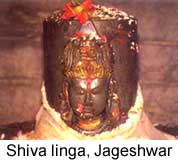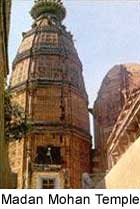.......Continued
JAGESHWAR
 Numerous 9th-8th-century Hindu stone temples typical of the Pratihara period stand at this site. Walls and curved towers are provided with shallow projections; towers are divided into slender horizointal mouldings. The amalakas at the summits are concealed within later overhanging wooden roofs. These temples are located near the beautiful tourist hill station of Almora.
Numerous 9th-8th-century Hindu stone temples typical of the Pratihara period stand at this site. Walls and curved towers are provided with shallow projections; towers are divided into slender horizointal mouldings. The amalakas at the summits are concealed within later overhanging wooden roofs. These temples are located near the beautiful tourist hill station of Almora.
Natesha Temple, 9th century
This shrine is typical of the smaller examples. The outer walls are plain except for small niches surmounted by triangular pediments. The doorway has finely carved motifs, including sculptures of the river goddesses. Above is a large projection with a triple-headed bust of Shiva and a dancing image of the god; a lion sits on top.
Mrityunjaya Temple, 10th century
This is the largest and best-preserved temple at the site. It is adorned with Shiva sculptures on its outer walls and tower; the triple heads of the deity are also carved on to the front (east) projection of the tower. The most interesting feature of the interior is the decorated sanctuary doorway.
Nava Durga Temple, 9th-10th century
This rectangular shrine with a vaulted roof now serves as a sculpture store. Among the metal images is a large 9th-10th-century figure, possibly the portrait of a royal patron.
VRINDAVAN (U.P.)
 Govindadeva Temple (1590)
Govindadeva Temple (1590)
Only the large mandapa of this temple still stands; the towered sanctuary was destroyed on the orders of Aurangzeb. The mandapa is an open structure in a stepped plan. Its exterior has projecting porches and open balconies on two storeys; these are enlivened with elaborate brackets and overhanging eaves. The walls are notable for their sharply cut mouldings; nowhere is there any figural sculpture. True arches, pointed vaults and even a dome cover the interior space.
Jagat Kishore Temple (16th century)
The entrance to this temple is framed within a recessed arch above which is a stylized foliate design. Over the sanctuary, rises an octagonal tapering tower. Its sides have vertical incisions and horizontal bands; an amalaka is positioned at the summit.
Madan Mohan Temple (16th century)
This resembles the Jagat Kishore temple in many respects. The octagonal tower here rises more than 20 m (66 ft) high. The outer surface, which curves gently, is divided into panels, each with a foliate medallion; there is no figural sculpture
| 


